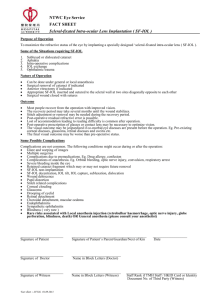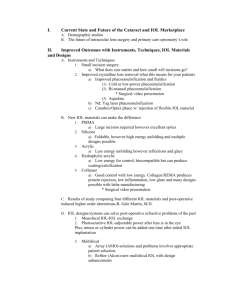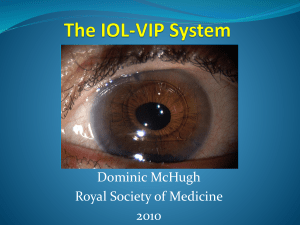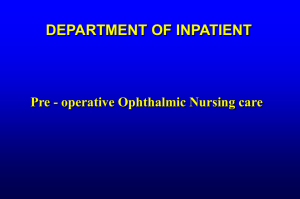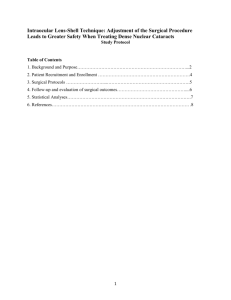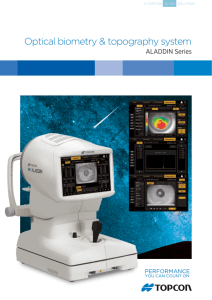PO-01 Outline
advertisement
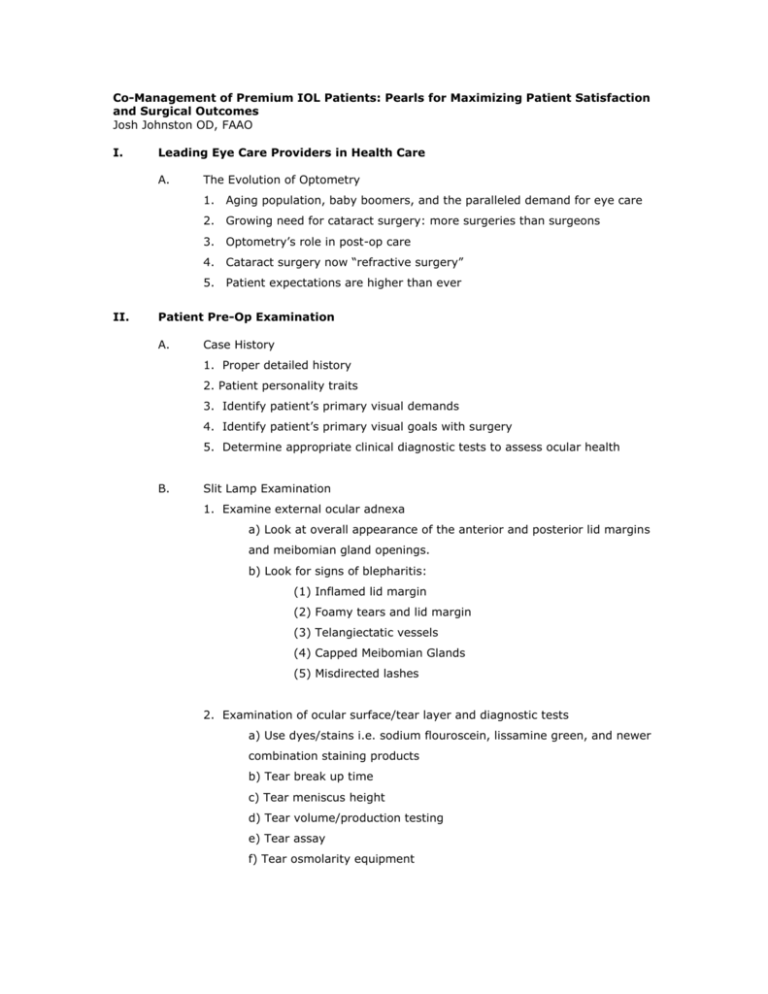
Co-Management of Premium IOL Patients: Pearls for Maximizing Patient Satisfaction and Surgical Outcomes Josh Johnston OD, FAAO I. Leading Eye Care Providers in Health Care A. The Evolution of Optometry 1. Aging population, baby boomers, and the paralleled demand for eye care 2. Growing need for cataract surgery: more surgeries than surgeons 3. Optometry’s role in post-op care 4. Cataract surgery now “refractive surgery” 5. Patient expectations are higher than ever II. Patient Pre-Op Examination A. Case History 1. Proper detailed history 2. Patient personality traits 3. Identify patient’s primary visual demands 4. Identify patient’s primary visual goals with surgery 5. Determine appropriate clinical diagnostic tests to assess ocular health B. Slit Lamp Examination 1. Examine external ocular adnexa a) Look at overall appearance of the anterior and posterior lid margins and meibomian gland openings. b) Look for signs of blepharitis: (1) Inflamed lid margin (2) Foamy tears and lid margin (3) Telangiectatic vessels (4) Capped Meibomian Glands (5) Misdirected lashes 2. Examination of ocular surface/tear layer and diagnostic tests a) Use dyes/stains i.e. sodium flouroscein, lissamine green, and newer combination staining products b) Tear break up time c) Tear meniscus height d) Tear volume/production testing e) Tear assay f) Tear osmolarity equipment III. Current Treatment Protocols for Ocular Surface Disease A. Maximize Ocular Surface Prior to Surgery 1. OTC treatments 2. Prescription topical medications 3. Nutritional supplements 4. Prescription oral medications 5. Proper management and treatment of systemic disease 6. In office treatments: a) Punctual occlusion, meibomian gland expression IV. Possible Contraindications for Premium IOL’s A. May limit visual outcome: a) Recurrent corneal erosions, corneal scar - consider PTK b) Pterygium - causing irregular and induced astigmatism c) Corneal edema/Fuch’s/Corneal guttata d) Amblyopia e) Previous trauma/PXE/Iris atrophy/weak zonules/Floppy Iris Syndrome f) Retinal pathology g) Advanced glaucoma h) Binocular vision problems V. Managing Pre-op Expectations 1. “Under promise and over deliver” 2. Glare and halos 3. Complete independence from glasses? 4. Refractive surgery “enhancement” after cataract surgery a) LASIK b) PRK c) LRI 5. Hand holding and extra customer service 6. Out of pocket costs, covered vs. non covered costs 7. Neuro adaptation 8. Yag Capsulotomy; perceived by patients as a complication to cataract surgery 9. Number one patient frustration is residual refractive error VI. 1 Day Post Op Examination A. Check visual acuity B. Check IOP C. Corneal edema/folds on Descemets Membrane D. Check wound for leakage/(+), (-) Seidel E. Clinical reason for decreased vision (1) dilate if needed (2) patient reassurance F. Causes of blurred visual acuity/post op complications a) corneal edema b) pharmacologic mydriasis c) retinal detachment d) prolapsed iris e) corneal abrasion f) endophthalmitis g) bullae from increased IOP/edema h) elevated IOP i) residual viscoelastic in anterior chamber j) residual cortex in anterior chamber, posterior chamber k) decentration of IOL, subluxed IOL l) IOL in sulcus secondary to torn bag m) vitreous in anterior chamber n) secondary uveitis VII. Follow Up Examination at 1 Week and 1 Month 1. Monitor VA 2. Follow patient for CME 3. Monitor IOP 4. Manage patient expectations VIII. Photographs of Common Post Op Complications a) corneal edema b) prolapsed iris c) vitreous prolapse into anterior chamber d) endophthalmitis e) decentration of IOL IX. Proper Management of Post Op Complications A. Elevated IOP after surgery 1. Fast acting ocular hypotensives such as beta blockers, adrenergic receptor agonists, CAI’s, combination drops 2. Oral medications: glycerol, acetazolamide PO B. Paracentesis/Burping wound a) Use a 20, 27, or 30 gauge needle or sterile Q-tip applied to sclera, peripheral to incision site after installing a drop of fluorescein to release residual viscoelastic or aqueous from wound b) Fluorescein will begin to “clear” as aqueous/viscoelastic comes out of wound c) IOP spike will occur 30-60 minutes again after paracentesis d) Maintain topical and oral ocular hypotensives until IOP regulated C. Wound Leak 1. Decrease topical steroid to promote healing of wound 2. Prescribe fast acting topical ocular hypotensive agent to decrease IOP and lower internal forces exerted on incision site 3. Place bandage contact lens on eye to cover wound, blocking entry by pathogen 4. Increase topical antibiotic q 2 hours 5. Remove bandage contact lens every day to exam if wound has healed and adjust post op drops accordingly 6. Suture will need to be placed in 48-72 hours if wound has not healed D. Check proper axis alignment with Toric IOL patients 1. Dilate patient, look at axis indicators 2. If off axis surgeon may need to rotate/realign in OR E. Multifocal IOL’s 1. Educate patients on glare, halos, neuroadaptation 2. Look for proper centration of IOL F. Accomodating IOL’s 1. Cycloplege patients for 2 weeks after surgery to prevent ciliary body movement and IOL shifting anterior 2. Use readers for 2 weeks for near work to prevent a myopic shift 3. After 2 weeks D/C readers and begin near exercises to strengthen ciliary body X. Proper Billing and Coding 1. Selection of proper diagnosis codes 2. Relevant diagnosis codes a) Review of ICD-9 codes 3. Procedure codes for endothelial cell microscopy, closure of lacrimal puncta, anterior segment photos, tear osmolarity testing, topography, A- scan, OCT’s 4. CPT Codes, modifiers XI. Profit and Value in Co Management of Premium IOL’s 1. Review reimbursement rates for co-management a) Comprehensive exam b) Follow up visits c) Diagnostic tests d) In office procedures e) OTC products f) Co-management fees 2. Financial impact of co-managing cataract cases and premium IOL’s a) Data on profitability created co-managing premium IOL’s XII. Case Studies of Cataract Surgeries 1. Case study #1 2. Case study #2 3. Case study #3 XIII. Conclusion and Clinical Pearls Managing Patients 1. Aggressively discuss, treat, and manage residual refractive error 2. “Under promise and over deliver” 3. Proper selection of various premium lens technologies for patients 4. Setting realistic patient expectations


